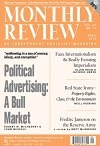Volume 63, Issue 11 (April)

For decades we have been arguing in Monthly Review that stagnation is the normal state of the mature monopoly-capitalist economies. Today the reality of stagnation is increasingly gaining the attention of the corporate media itself.… For those accustomed to thinking of the capitalist economy as either growing rapidly or occasionally falling into a severe crisis (from which it quickly bounces back), long-run stagnation is a difficult to understand phenomenon. [A stagnating economy] neither collapses into a full (or “classic”) crisis, which would allow it to clear out (or devalue) its overaccumulated capital, nor is it able to achieve a full recovery. Instead, it remains caught in a stagnation trap, limping along at a low rate of growth, with high unemployment and excess capacity. Under the circumstances—and without the help of some external stimulus like a major war, a financial bubble, or an epoch-making innovation—the capital accumulation process is unable to move off dead center. | more…
The United States is in the midst of its quadrennial presidential election, a process that now extends so long as to be all but permanent. The campaign is also drenched in more money given by a small handful of billionaires than has been the case in the past. Since the 1970s the amount spent on political campaigns has increased dramatically in almost every election cycle. It has led to the formation of what we term the “money-and-media election complex,” which has a revenue base in the many billions of campaign dollars donated annually, and has effectively become the foundation of electoral politics in the United States. Moreover, the rate of increase in campaign spending from 2008 to 2010, and especially from 2008 to 2012, is now at an all-time high. | more…
The Role of the Federal Reserve System in Keeping Wages Low
Economist Edwin Dickens has written a series of significant articles analyzing the minutes of the meetings, dating back to the 1950s, of the Open Market Committee of the Federal Reserve Board. (The Committee is the main policy-making body of the Board.) Dickens’s research shows convincingly that the Federal Reserve’s partisan behavior is designed to tilt the economy in the direction of the wealthy by making workers more compliant.… A recent study formalized Dickens’s work by attempting to distinguish whether the policy actions of the Federal Reserve were responses to inflation or to low unemployment. The study concluded that “a baseless fear of full employment,” rather than the prevention of inflation, was the guiding principal of the Federal Reserve. The conclusion of this study should come as little surprise to people familiar with the Federal Reserve’s obsession with the danger of high wages. | more…
If truth is the first casualty of war, military intervention in the name of humanitarian ideals should likewise be the subject of skepticism. Such an approach is called for as the discourse of the Responsibility to Protect civilian populations is becoming a doctrinal principle in the West’s foreign policy toolbox. The notion that these big powers have the right to intervene in other (weak) countries’ internal affairs threatens to transform the foundation, if not the praxis, of international law.… Simultaneously, the ideology of “humanitarian interventionism,” which stands almost uncontested, can be interpreted as legitimizing a hidden political agenda. It has the potential of blurring existing ideological and political differences between neoconservatives, liberal internationalists in the United States and Europe, and a large section of left-wing forces around the world. All these currents have found common grounds in vindicating NATO’s military violations of the principle of national sovereignty. | more…
The last four or five decades have seen extraordinary economic and population growth in the southern states of the United States, continuing historic developments that started during the Second World War and were later stimulated by the end of legal racial segregation. One national effect of those changes has been a continual shift in the center of economic growth for the whole country to the southern and western states, away from the Northeast and the Midwest “rust belt.” The character of the exploitation of labor in the South has changed as investment patterns have displaced large populations from manufacturing and extractive employment.… This new “New South” has been widely celebrated, even as regional wage rates still trail other sections of the country (and while the South shares the national upward redistribution of wealth). What is different now from the pattern in the 1950s is that realizing a return on investment by the sweating-it-out of workers is nothing like the obvious low-cost option it was then. | more…
In the opening pages of The Limits to Capital, published in 1984, David Harvey jokes that everyone who reads Marx’s Capital seems bound to write a book about it. In 2012, we might well ask: Just one? Last year, many of the long-standing academic Marxists unleashed new introductory works, including Terry Eagleton, David Harvey, Eric Hobsbawm, and, unsurprisingly, Fredric Jameson. In Representing Capital, Jameson has written the best of the bunch: a surprising, energetic, and concise representation of the “totality” of capital. | more…
